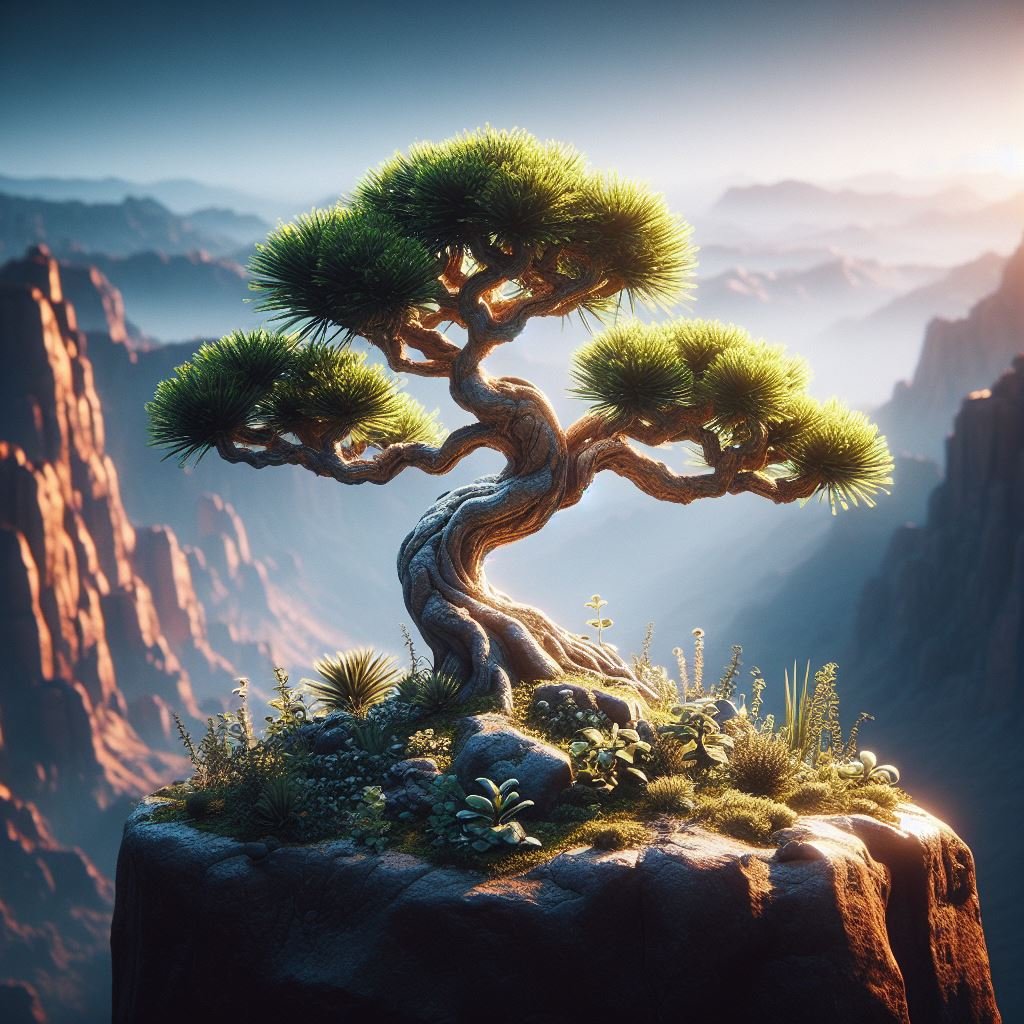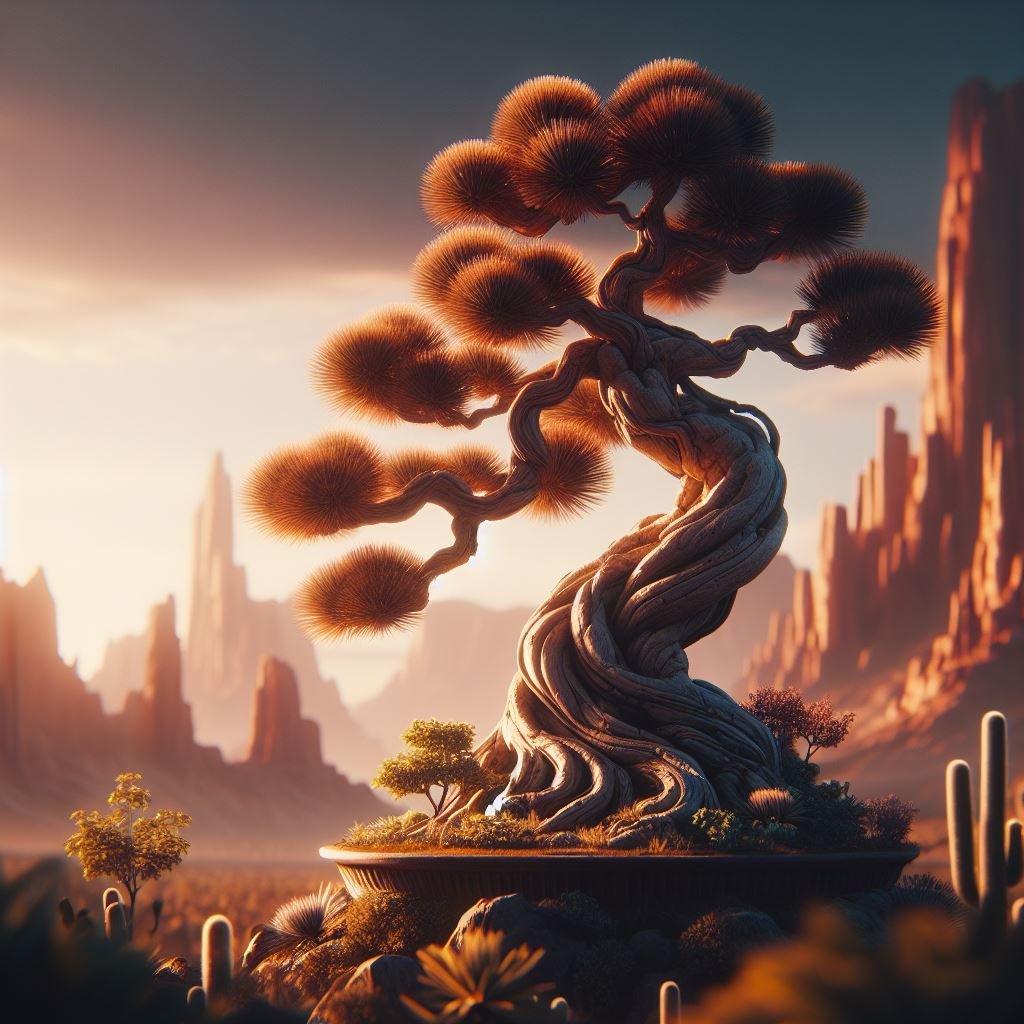If you’re a passionate plant enthusiast, you’ve probably heard about, or maybe even owned, bonsai trees. These miniature wonders have fascinated horticulturists for centuries. But have you ever come across a Bonsai Joshua Tree? This unique version of the bonsai family brings a hint of the desert into your home or garden. In this guide, we’ll introduce you to the captivating world of Bonsai Joshua Trees, from their history to their care requirements, common problems, and some intriguing facts.
History of Bonsai Joshua Tree
The Joshua Tree, native to the arid southwestern United States, has been an iconic symbol of resilience, beauty, and survival. Named by Mormon settlers crossing the Mojave Desert, who saw in their twisted branches the outstretched arms of Joshua guiding them to the promised land. The tradition of cultivating these trees as bonsai began many years later, reflecting their unique aesthetic and cultural significance in the miniature form.
How to Grow and Care for Bonsai Joshua Tree
Growing a Bonsai Joshua Tree can be a rewarding experience. With the right care and attention, you can nurture a tiny piece of the desert wilderness in your own home.

Selecting the Right Tree
Choose a young Joshua Tree seedling or a mature tree from a reliable nursery. Ensure the tree looks healthy, with firm branches and no visible signs of pests or diseases.
Potting and Soil Requirements
Use a shallow bonsai pot with adequate drainage. A sandy, well-drained soil mix, similar to its natural desert habitat, is ideal.
Watering and Fertilization
Joshua Trees are adapted to dry conditions. Water deeply but infrequently, allowing the soil to dry out between watering. Fertilize monthly during the growing season with a balanced bonsai fertilizer.
Pruning and Shaping Techniques
Pruning should be done sparingly to maintain the tree’s natural form. Use bonsai wire carefully to shape the branches, mimicking the tree’s wild counterparts.
Sunlight and Temperature Considerations
The Bonsai Joshua Tree loves plenty of sunlight and can tolerate high temperatures. However, it’s not frost-tolerant, so ensure to move it indoors during harsh winters.
Common Problems and Solutions
Like all plants, Bonsai Joshua Trees can encounter some issues. Let’s look at some common problems and solutions:

Pest Infestations
Monitor your tree regularly for signs of pests such as aphids or spider mites. An insecticidal soap or neem oil can help control these pests.
Diseases and Infections
Fungal diseases can be a problem if the tree is overwatered or the soil doesn’t drain well. If you notice any unusual spots or discoloration, consult with a plant disease expert or a local nursery.
Nutrient Deficiencies
Yellowing or dropping leaves can indicate a nutrient deficiency. Regular fertilization should prevent this, but if symptoms persist, consider a specialized bonsai nutrient supplement.
Overwatering or Underwatering
Both overwatering and underwatering can harm your Joshua Tree. Always check that the top layer of the soil is dry before watering again.
Interesting Facts about Bonsai Joshua Tree
Now that we’ve covered the practical aspects of caring for a Bonsai Joshua Tree let’s delve into some fascinating facts about this unique plant:

- Resilience: The Joshua Tree is known for its resilience in the harsh desert climate, often living for hundreds of years.
- Night Blooming: Joshua Trees bloom at night, producing beautiful white flowers that are pollinated by a single species of moth.
- Symbolism: In many cultures, the Joshua Tree symbolizes resilience, endurance, and the will to survive against all odds.
- Unique Specimens: Some Bonsai Joshua Trees have been cultivated for decades, becoming unique works of art and fetching high prices in the bonsai collector’s market.
What’s special about Joshua tree?
The Joshua Tree, scientifically known as Yucca brevifolia, is native to the southwestern United States and northwestern Mexico. This tree is particularly special because it thrives in two distinct desert ecosystems, the Mojave and the Colorado, which come together in Joshua Tree National Park.
The park itself is a beloved natural gem where arid low desert and vegetated high desert meet, offering visitors stunning vistas, rewarding hikes, and a haven for fans of nature trails, dark skies, camping, desert flora and fauna, and rock climbing. It has inspired artists and musicians for more than 75 years.
Moreover, the Joshua tree is not just a plant; it’s a vital part of the desert ecosystem. Many animals depend on it for food and shelter, including birds, mammals, insects, and reptiles. The tree’s flowers are pollinated by the yucca moth, which spreads the tree’s pollen while laying its eggs inside the flower. The larvae feed on the seeds of the tree, but enough seeds are left behind to produce more trees. The Joshua tree is also a host plant for several types of butterflies.
- A thread on BonsaiNut.com discusses the potential of Joshua Trees as bonsai. Some users consider them more of a novelty tree than a traditional bonsai. Source
- Sites such as GetTreesFast and Walmart offer Joshua Tree Bonsai Seeds for sale, indicating there is interest in growing these trees as bonsai. Source Source
- The Western Joshua Tree Status Review collects data on the presence and coverage of Joshua Trees. While not specific to bonsai, this survey provides valuable information on the health and distribution of the species. Source
- The City of Hesperia conducted a survey and evaluation of native desert plants, including Joshua Trees, on October 27, 2021, and January 13, 2022. Source
- National Park Service ↩
- Wikipedia – Yucca brevifolia ↩
- National Geographic – Joshua Tree National Park ↩
| Source | Information |
|---|---|
| BonsaiNut.com | Discussion thread on growing Joshua Tree as bonsai. Indicates fast growth and deep root system. |
| Amazon.com | Joshua Tree Bonsai Seeds available for purchase, shipped from Iowa, USA. Marketed as ‘highly prized’. |
| GetTreesFast.com | Offers 10 seeds for growing Joshua Tree bonsai. Mentions Yucca brevifolia as a typical species of the Mojave desert. |
| Reddit.com | User plans to grow mini Joshua Tree bonsai. Describes it as a sedum with a tree-like structure. |
| Sequoiatrees.com | Seed Grow Kit for starting Joshua Tree bonsai from seed. Kit includes seeds, growing medium, mini-greenhouse, and instructions. |
| Joshua Hooson, bonsai nursery owner, shares images and information about various bonsai trees. | |
| Features image and info about pygmy Joshua Tree (Sedum multiceps) bonsai, including care instructions. | |
| Etsy.com | Listing for a set of 4 small indoor planters potentially suitable for Joshua Tree bonsai. |
| Walmart.com | Joshua Tree Bonsai Seeds for purchase, also marketed as ‘highly prized’. |
Conclusion
The Bonsai Joshua Tree is an extraordinary plant that captures the grandeur of the desert in miniature form. By understanding its origins and care requirements, you can appreciate this tree’s beauty and resilience and perhaps be inspired to start or expand your bonsai collection. Remember, the joy of bonsai cultivation lies not just in the end result but in the entire nurturing process. So take the plunge and embark on your Bonsai Joshua Tree adventure today!
Frequently Asked Questions (FAQs)
How often should I water my Bonsai Joshua Tree?
- Water deeply but infrequently, allowing the soil to dry out between watering. Always check that the top layer of the soil is dry before watering again.
Can Bonsai Joshua Trees grow indoors?
Yes, as long as they receive plenty of sunlight. However, remember to move them indoors during harsh winters as they are not frost-tolerant.
What kind of soil is best for a Bonsai Joshua Tree?
A sandy, well-drained soil mix, similar to its natural desert habitat, is ideal for a Bonsai Joshua Tree.
What pests are common to the Bonsai Joshua Tree?
Common pests include aphids and spider mites. You can control these pests with insecticidal soap or neem oil.
What signs should I look for to know if my Bonsai Joshua Tree is healthy?
A healthy tree will have firm branches, no visible signs of pests or diseases, and won’t show discoloration or dropping leaves.





